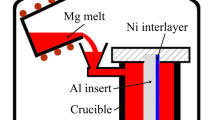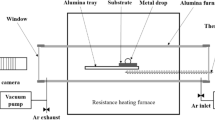Abstract
In this study, wetting has been characterized by measuring the contact angles of AZ92 Mg alloy on Ni-electroplated steel as a function of temperature. Reactions between molten Mg and Ni led to a contact angle of about 86 deg in the temperature range of 891 K to 1023 K (618 °C to 750 °C) (denoted as Mode I) and a dramatic decrease to about 46 deg in the temperature range of 1097 K to 1293 K (824 °C to 1020 °C) (denoted as Mode II). Scanning and transmission electron microscopy (SEM and TEM) indicated that AlNi + Mg2Ni reaction products were produced between Mg and steel (Mg-AlNi-Mg2Ni-Ni-Fe) in Mode I, and just AlNi between Mg and steel (Mg-AlNi-Fe) in Mode II. From high resolution TEM analysis, the measured interplanar mismatches for different formed interfaces in Modes I and II were \( 17{\kern 1pt} \;{\text{pct}}_{{\{ 10\overline 11\}_{\text{Mg}} //\{ 110\}_{\text{AlNi}} }} \)-\( 104.3\;{\text{pct}}_{{\{ 110\}_{\text{AlNi}} //\left\{ {10\overline{1}0} \right\}_{{{\text{Mg}}_{ 2} {\text{Ni}}}} }} \)-\( 114\,{\text{pct}}_{{\left\{ {0003} \right\}_{{{\text{Mg}}_{ 2} {\text{Ni}}}} //\{ 111\}_{\text{Ni}} }} \) and \( 18\,{\text{pct}}_{{\{ 10\overline 11\}_{\text{Mg}} //\{ 110\}_{\text{AlNi}} }} \)-\( 5\,{\text{pct}}_{{\left\{ {110} \right\}_{\text{AlNi}} //\{ 110\}_{\text{Fe}} }} \), respectively. An edge-to-edge crystallographic model analysis confirmed that Mg2Ni produced larger lattice mismatching between interfaces with calculated minimum interplanar mismatches of \( 16.4\,{\text{pct}}_{{{\text{\{ 10}}\overline 1 1 {\text{\} }}_{\text{Mg}} / / {\text{\{ 110\} }}_{\text{AlNi}} }} \)-\( 108.3\,{\text{pct}}_{{{\text{\{ 110\} }}_{\text{AlNi}} / / {\text{\{ 10}}\overline 1 1 {\text{\} }}_{{{\text{Mg}}_{ 2} {\text{Ni}}}} }} \)-\( 17.2\,{\text{pct}}_{{{\text{\{ 10}}\overline 1 1 {\text{\} }}_{{{\text{Mg}}_{ 2} {\text{Ni}}}} / / {\text{\{ 100\} }}_{\text{Ni}} }} \) for Mode I and \( 16.4\,{\text{pct}}_{{{\text{\{ 10}}\overline1 1 {\text{\} }}_{\text{Mg}} / / {\text{\{ 110\} }}_{\text{AlNi}} }} \)-\( 0.6\,{\text{pct}}_{{{\text{\{ 111\} }}_{\text{AlNi}} / / {\text{\{ 111\} }}_{\text{Fe}} }} \) for Mode II. Therefore, it is suggested that the poor wettability in Mode I was caused by the existence of Mg2Ni since AlNi was the immediate layer contacting molten Mg in both Modes I and II, and the presence of Mg2Ni increases the interfacial strain energy of the system. This study has clearly demonstrated that the lattice mismatching at the interfaces between reaction product(s) and substrate, which are not in direct contact with the liquid, can greatly influence the wetting of the liquid.














Similar content being viewed by others
References
G. Bailey and H. Watkins: J. Inst. Met., 1952, vol. 80, pp. 57-76.
G. Kumar and K.N. Prabhu: Adv. Colloid Interface Sci., 2007, vol. 133, pp. 61-89.
A.M. Nasiri, P. Chartrand, D.C. Weckman, and Y. Zhou: Metall. Mater. Trans. A, 2013, vol. 44A, pp. 1937-46.
N. Eustathopoulos: Acta Mater., 1998, vol. 46, pp. 2319-27.
I. Aksay, C. Hoye, and J. Pask: J. Phys. Chem., 1974, vol. 78, pp. 1178-83.
N. Eustathopoulos and B. Drevet: J. Phys. III, 1994, vol. 4, pp. 1865-81.
E. Saiz, C.W. Hwang, K. Suganuma, and A.P. Tomsia: Acta Mater., 2003, vol. 51, pp. 3185-97.
L.B. Freund and S. Suresh: Thin Film Materials, Stress, Defect Formation and Surface Evolution, University Press, Cambridge, 2003.
M.E. Glicksman: Principles of Solidification, Springer Science+Business Media, LLC 2011, DOI:10.1007/978-1-4419-7344-3_12 .
L.M. Liu: Welding and Joining of Magnesium Alloys, Woodhead Publishing Limited, Cambridge, 2010.
N. Eustathopoulos, M.G. Nicholas, and B. Drevet: Wettability at High Temperatures, Pergamon Materials Series, Oxford, 1999, p. 187, 202, 399.
R. Voitovitch, A. Mortensen, and N. Eustathopoulos: Acta Mater., 1999, vol. 47, pp. 1117-28.
O. Dezellus, F. Hodaj, and N. Eustathopoulos: Acta Mater., 2002, vol. 47, pp. 4741-53.
A.M. Nasiri, D.C. Weckman, and Y. Zhou: Weld. J., 2013, vol. 92, pp. 1-10.
Material Safety Data Sheet 2003, Superior Flux & Mfg. Co., November 11.
T.M. Moore: Microsc. Today, 2005, vol. 13, p. 40.
N.A. Belov, D.G. Eskin, and N.N. Avxentieva: Acta Mater., 2005, vol. 53, pp. 4709-22.
A. Gasparyan and A. Shteinberg: Combus. Explos. Shock Waves, 1988, vol. 24, pp. 324-30.
W.B. Pearson: Lattice Spacings and Structures of Metals and Alloys, Pergamon Press, New York.
E. Abe, Y. Kawamura, K. Hayashi, and A. Inoue: Acta Mater., 2002, vol. 50, pp. 3845-57.
D. Turnbull and R. Vonnegut: Ind. Eng. Chem., 1952, vol. 44, pp. 1292-98.
M.X. Zhang and P.M. Kelly: Acta Mater., 2005, vol. 53, pp. 1073-84.
M.X. Zhang and P.M. Kelly: Acta Mater., 2005, vol. 53, pp. 1085-96.
J.H. van der Merwe: Phil. Mag. A, 1982, vol. 45, pp. 127-43.
D. Duly: Acta Metall. Mater., 1993, vol. 41, pp. 1559-66.
Acknowledgments
The authors wish to acknowledge support of the Magnesium Network of Canada (MagNET) supported by the Natural Sciences and Engineering Research Council of Canada (NSERC) and American Welding Society (AWS) Graduate Fellowship program for sponsoring this work.
Author information
Authors and Affiliations
Corresponding author
Additional information
Manuscript submitted May 26, 2014.
Appendix: Lattice Matching Calculation Using Edge-to-Edge Model
Appendix: Lattice Matching Calculation Using Edge-to-Edge Model
Table AI shows the close-packed directions and planes together with their interatomic or interplanar spacings as a function of lattice parameters for different crystal structures observed in this study.
1.1 Mg (HCP)-AlNi (BCC) Interface (Modes I & II)
For the HCP and BCC crystal structures, there are three and four possible close-packed or nearly close-packed directions (directions with low indices), respectively (see Table AI). Among these directions, \( \langle 10\overline 1 0\rangle_{HCP} \), \( \langle 11\overline 2 3\rangle_{HCP} \), and \( \langle 113\rangle_{BCC} \) are zigzag atom rows and the rest are straight atom rows.[22] Therefore, there are a total of five possible matching direction pairs between HCP and BCC. Table AII shows the calculated interatomic spacings for Mg and AlNi and interatomic misfits along possible matching directions between them. The lattice parameters used in the current study are a H = 0.320 nm and c H = 0.520 nm for Mg and a B = 0.288 nm for AlNi.[19] The calculated results (Table AII) indicate that if 10 pct is selected as the critical value of the interatomic spacing misfit, just direction pair of \( \langle 11\overline 20\rangle_{\text{Mg}} \)//\( \langle 100\rangle_{\text{AlNi}} \) satisfies this condition. The selection of 10 pct as the critical value for the interatomic spacing misfit is based on van der Merwe’s energy calculation, which was done along the close-packed directions between FCC and body-centered cubic (BCC).[22,24]
Identification of matching planes is the next step to predict the OR between Mg (HCP) and AlNi (BCC) crystal structure. These planes can be identified by calculation of structure factors or by looking at the powder X-ray diffraction intensities available from the published XRD databases. The biggest structure factor or the highest intensity of the X-ray diffraction corresponds to the closest-packed plane. In both HCP and BCC crystal structures, there are three close-packed or nearly close-packed planes (as shown in Table AI). Thus, there are nine possible plane pairs between HCP and BCC crystal structures. Table AIII shows the calculated results for the interplanar spacing mismatches between possible matching planes between Mg and AlNi.
To form an OR without large mismatch strain, the edge-to-edge matching model also requires a critical interplanar spacing mismatch value between matching planes, similar to the interatomic spacing misfit along matching directions. It has been reported that the approximate critical d-value mismatch is less than 6 pct, which is based on reported ORs in known systems.[25] Using 6 pct as the critical value, it can be concluded that there are no potential matching planes between Mg and AlNi (see Table AIII). Therefore, the formed OR between Mg and AlNi will have a high interplanar mismatch with large angle rotation of the matching planes (see Figures 7(d) and 11).
1.2 AlNi (BCC)-Mg2Ni (HCP) Interface (Mode I)
The lattice parameters used in the current study are a H = 0.518 nm and c H = 1.319 nm for Mg2Ni.[19] Table AIV shows the calculated results for the relative interatomic spacing misfits along possible matching directions between AlNi and Mg2Ni. Table AV shows the calculated interplanar spacings for AlNi and Mg2Ni and interplanar spacing mismatches. No potential matching direction was found between AlNi and Mg2Ni with δ less than the critical value of 10 pct (see Table AIV). Also, there are no potential matching planes between AlNi and Mg2Ni with interplanar spacing mismatch less than the critical value of 6 pct (see Table AV). These lead to a large angle rotation of the matching planes with high interplanar mismatch between AlNi and Mg2Ni (see Figure 8).
1.3 Mg2Ni (HCP)-Ni (FCC) Interface (Mode I)
In FCC crystal structures, there are three close-packed or nearly close-packed directions (all straight atom rows) and three close-packed or nearly close-packed planes (see Table AI). With this assumption that the Ni (FCC) is the parent phase (substrate), and Mg2Ni phase (HCP) is formed on the substrate as the product, Table AVI shows the calculated interatomic spacings for Mg2Ni and Ni and interatomic misfits along possible matching directions (all pairs are straight) between them (a F = 0.352 nm for Ni[19]). Calculated results (Table AVI) show that there are no potential matching directions with the interatomic spacing misfit less than the critical value of 10 pct between the Ni-electroplated layer and the Mg2Ni phase at the interface. Table AVII shows the calculated results for the interplanar spacing mismatches between possible matching planes between Mg2Ni phase and Ni. Using 6 pct as the critical value, it can be concluded that there are no potential matching planes between Mg2Ni and Ni (see Table AVII), and, therefore, a large angle rotation of matching planes with high interplanar mismatch forms between Mg2Ni and Ni (see Figure 9(c)).
1.4 AlNi (BCC)-Fe (BCC) Interface (Mode II)
The lattice parameter used for Fe was 0.286 nm.[19] With the assumption that Fe is the substrate and AlNi is the formed phase (product), Tables AVIII and AIX show the calculated results for the relative interatomic spacing misfits and interplanar spacing mismatches between Fe and AlNi, respectively. The interatomic spacing misfits less than the critical value of 10 pct between the AlNi phase and Fe substrate at the interface were found along \( \langle 111\rangle_{\text{Fe}} \)//\( \langle 111\rangle_{\text{AlNi}} \), \( \langle 100\rangle_{\text{Fe}} \)//\( \langle 100\rangle_{\text{AlNi}} \), \( \langle 110\rangle_{\text{Fe}} \)//\( \langle 110\rangle_{\text{AlNi}} \), and \( \langle 113\rangle_{\text{Fe}} \)//\( \langle 113\rangle_{\text{AlNi}} \) (see Table AVIII). Also, the interplanar spacing mismatches less than the critical value of 6 pct are for \( \{ 110\}_{\text{Fe}} \)//\( \{ 110\}_{\text{AlNi}} \), \( \{ 200\}_{\text{Fe}} \)//\( \{ 200\}_{\text{AlNi}} \), and \( \{ 111\}_{\text{Fe}} \)//\( \{ 111\}_{\text{AlNi}} \) (see Table AIX). The plane pair of \( \{ 110\}_{\text{Fe}} \)//\( \{ 110\}_{\text{AlNi}} \) contains all the possible matching direction with small misfit values, but plane pair of \( \{ 200\}_{\text{Fe}} \)//\( \{ 200\}_{\text{AlNi}} \) only contains \( \langle 100\rangle_{\text{Fe}} \)//\( \langle 100\rangle_{\text{AlNi}} \) and \( \langle 110\rangle_{\text{Fe}} \)//\( \langle 110\rangle_{\text{AlNi}} \) direction pairs and the plane pair of \( \{ 111\}_{\text{Fe}} \)//\( \{ 111\}_{\text{AlNi}} \) just contains \( \langle 110\rangle_{\text{Fe}} \)//\( \langle 110\rangle_{\text{AlNi}} \) direction pair. Therefore, these combinations of plane pairs and the direction pairs have the potential to form an OR. These conditions lead to a low angle rotation of the lattice planes along the matching directions and a low mismatch strain at the interface of Fe and AlNi (see Figure 13).
Rights and permissions
About this article
Cite this article
Nasiri, A.M., Lee, M.Y., Weckman, D.C. et al. Effects of Interfacial Lattice Mismatching on Wetting of Ni-Plated Steel by Magnesium. Metall Mater Trans A 45, 5749–5766 (2014). https://doi.org/10.1007/s11661-014-2514-8
Published:
Issue Date:
DOI: https://doi.org/10.1007/s11661-014-2514-8




